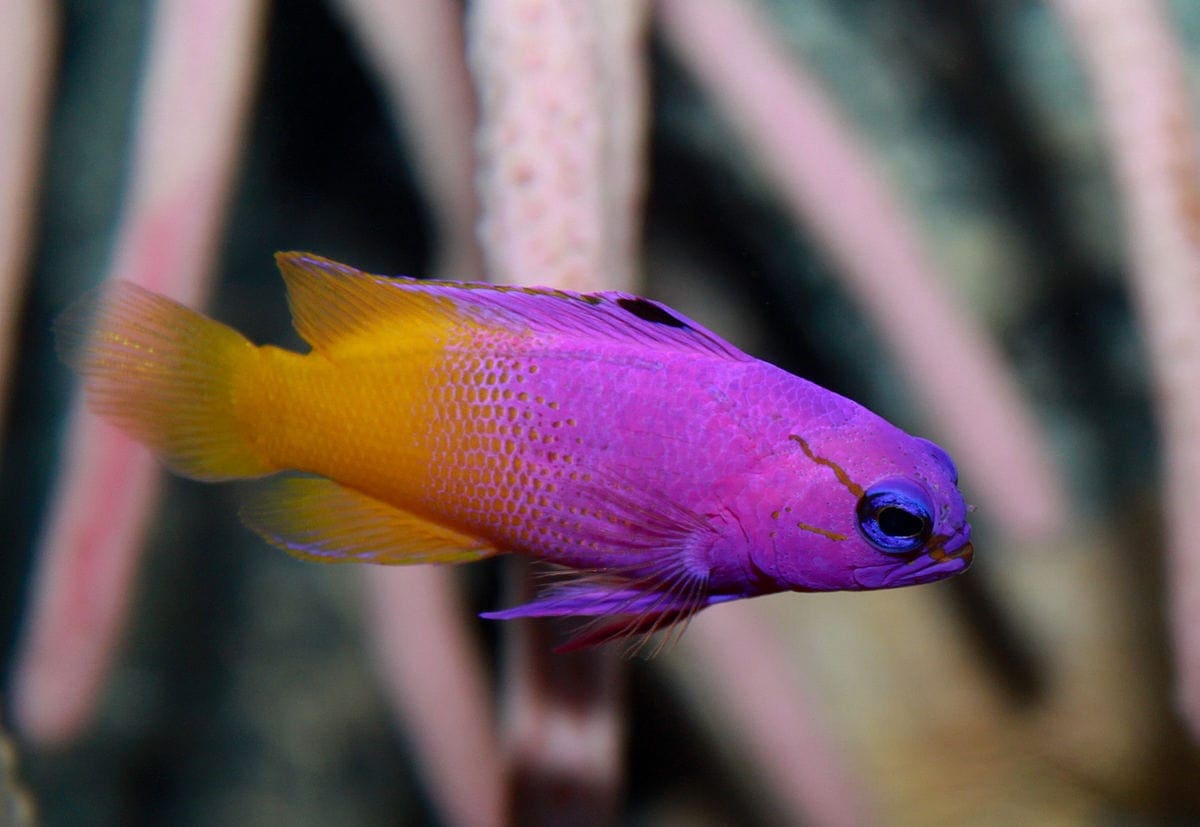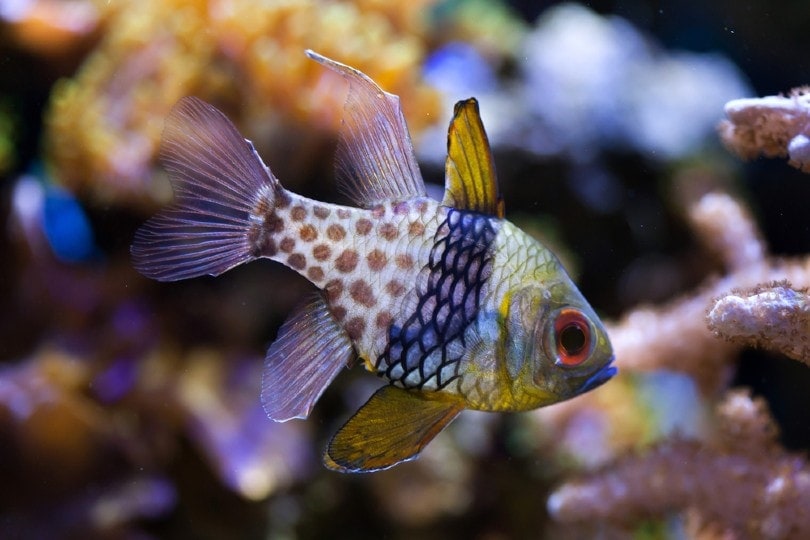10 Great Tank Mates for Seahorses: Compatibility Guide 2024

Updated on

Seahorses are fun little creatures to keep in your saltwater aquarium. There are about 36 species of seahorses found in the wild, and they are among the few fish that swim in an upright position. This characteristic makes them somewhat difficult to pair with tank mates because they are poor swimmers that cannot get away from aggressive or predatory fish.
However, that doesn’t mean it’s impossible to find good tank mates for seahorses. The following list includes a few matches that are appropriate for your seahorse.
The 10 Great Tank Mates for Seahorses
1. Court Jester Goby (Koumansetta rainfordi)

| Size: | 2 to 2.5 inches |
| Diet: | Omnivore |
| Minimum tank size: | 20 gallons |
| Care level: | Easy |
| Temperament: | Social, gentle |
Court Jester Gobies are peaceful fish that can live with many other species. They won’t bother your seahorses and will help keep the tank clean by feeding on algae. They are hardy fish and easy to care for. Their non-aggressive behavior makes them a nice addition to most tanks.
2. Royal Gramma (Gramma loreto)

| Size: | 3 inches |
| Diet: | Carnivore |
| Minimum tank size: | 30 gallons |
| Care level: | Easy |
| Temperament: | Peaceful |
The Royal Gramma will add bursts of color to any tank. They are vivid purple and yellow fish that are easy to care for. They also have a peaceful nature, so they won’t put your seahorses at risk of attack. While they won’t attack your seahorses, it’s important to note that they don’t always get along well with others of their own species, so they are best kept in singles in your tank.
3. Pajama Cardinalfish (Sphaeramia nematoptera)

| Size: | 3.5 inches |
| Diet: | Carnivore |
| Minimum tank size: | 20 gallons |
| Care level: | Easy |
| Temperament: | Peaceful |
The Pajama Cardinalfish is a brightly colored fish to add to your seahorse tank. They have green faces, orange eyes, and orange polka-dotted backsides. They are peaceful and like to live in small groups of their species. They’ll spend most of their time hiding among tank plants and rocks.
4. Radial Filefish (Acreichthys radiatus)
| Size: | 3 inches |
| Diet: | Carnivore |
| Minimum tank size: | 30 gallons |
| Care level: | Easy |
| Temperament: | Curious, peaceful |
The Radial Filefish is an interesting addition to your tank. They can change colors, switching from brown, green, blue, and cream. They are curious and like to spend their days exploring your aquarium. They won’t bother your other fish on their exploration expeditions, so they are good tank mates for seahorses.
5. Molly Miller Blenny (Scartella cristata)
| Size: | 4 inches |
| Diet: | Omnivore |
| Minimum tank size: | 30 gallons |
| Care level: | Moderate |
| Temperament: | Calm, peaceful |
The Molly Miller Blenny isn’t the most beautiful fish that you can add to your tank, but they make up for it in utility. These useful fish help keep your tank clean by eating potentially harmful algae and other detritus. This is helpful for sensitive seahorses that require a pristine tank.
6. Spotted Mandarin (Synchiropus picturatus)
| Size: | 3 inches |
| Diet: | Carnivore |
| Minimum tank size: | 30 gallons |
| Care level: | Difficult |
| Temperament: | Calm, shy |
The Spotted Mandarin is a little harder to care for than some other potential seahorse tank mates. This is primarily because these brightly colored fish need clean, temperature-controlled aquariums, much like seahorses. Otherwise, they are peaceful and will get along just fine with your seahorses.
7. Red Firefish (Nemateleotris magnifica)
| Size: | 3 inches |
| Diet: | Carnivore |
| Minimum tank size: | 20 gallons |
| Care level: | Easy |
| Temperament: | Peaceful |
The Red Firefish has a beautiful bright red or purplish-red tail that fades into a white, almost clear head, with some yellow on the face. They do well in small groups and like to hide together for protection. They aren’t aggressive and won’t bother your other fish. However, they have been known to jump out of tanks if they feel stressed, so make sure you have a tight-fitting lid on your aquarium.
8. Orange-Lined Cardinalfish (Sphaeramia nematoptera)

| Size: | 2.5 inches |
| Diet: | Carnivore |
| Minimum tank size: | 10 gallons |
| Care level: | Easy |
| Temperament: | Shy, peaceful |
The Orange-lined Cardinalfish, also known as the Yellow-Striped Cardinalfish, is a small, shy fish that makes a good tank mate for your seahorses. They like to spend most of their time hiding in your aquarium plants and won’t disturb your other fish. As their name implies, these little fish have yellow to orange stripes running up and down their sides.
9. Striped Mandarin (Synchiropus splendidus)
| Size: | 3 inches |
| Diet: | Carnivore |
| Minimum tank size: | 30 gallons |
| Care level: | Difficult |
| Temperament: | Peaceful |
Like their cousin, the Spotted Mandarin, the Striped Mandarin can be tricky to care for because of their specific water condition needs. They must have clean, ammonia-free conditions to thrive. They are beautiful additions to your tank, with bright blue, orange, and green stripes running around their bodies.
10. Ghost Shrimp (Penaeus sp.)

| Size: | 1.5 inches |
| Diet: | Omnivore |
| Minimum tank size: | 10 gallons |
| Care level: | Easy |
| Temperament: | Peaceful |
Ghost Shrimp can be useful additions to your tank. They will help keep your aquarium clean and require little care. They are clear, as their name implies, which helps them avoid predators. The one concern with these little shrimp is that they might become a source of food for larger fish in your tank.
What Makes a Good Tank Mate for Seahorses?
Good tank mates for seahorses are calm, peaceful fish that will leave your seahorses alone. It’s also important that tank mates generally eat a different diet from the seahorses so they don’t compete for food. Fish that clean your tank by eating algae and other debris are also good tank mates.
Seahorses are not fast swimmers. Therefore, they shouldn’t be kept in tanks with aggressive fish, as your seahorses will be left open to attack. Predatory fish larger than your seahorses may also try to eat them.
Where Do Seahorses Prefer to Live in the Aquarium?
Seahorses like to hang out in the middle of the tank. They will also hide in your aquarium plants to rest and wait for food. Since they are poor swimmers, you’ll need to provide them with plants or other perches that they can hang on to. You can keep more than one species of seahorse in your tank, but you need to make sure they are fed enough and don’t crowd each other.
Water Parameters
Seahorses are typically found in shallow tropical waters in the wild. Therefore, they require a clean, warm saltwater tank. The size of the tank is far less important than the quality of the water. They require clean, ammonia-free water with the right levels of salt.
Typically, they need water temperatures between 78 to 86 degrees Fahrenheit. The pH level should be maintained between 8.2 and 8.4. Dramatic variations in aquarium conditions can be fatal to seahorses, so you’ll need to monitor their tank conditions closely.
Size
Seahorses come in a wide range of sizes, from 1 to 14 inches. However, those commonly kept in aquariums are usually between 1 and 3 inches. They don’t have scales like most fish. Instead, they have bony plates with a thin layer of skin over them.
Aggressive Behaviors
Seahorses are not aggressive. They are rather shy and don’t like to be bothered by other fish. There is more risk to seahorses from other, more aggressive, fish. Seahorses cannot swim well and are easy prey for larger fish. They do get along well with other seahorses, though, so you can keep them together.

Top 3 Benefits of Having Aquarium Tank Mates for Seahorses
It’s important to note that it isn’t necessary to have tank mates for your seahorses. Often, it’s more risky than beneficial because of the seahorse’s specific water condition needs, poor swimming ability, and slow eating tendencies.
- Tank cleaners can help maintain the spotless environment that seahorses need.
- The addition of other species can brighten your tank.
- Peaceful species will often not trouble your seahorses and can recreate their natural habitat.

Final Thoughts
Seahorses are fascinating pets. They’re fun to watch and have been known to learn who their keeper is. Some people report that their seahorses will perform little dances for them when they notice their owner outside the tank.
However, these cute little creatures can be difficult to care for. They have specific tank condition requirements and cannot be kept with many species for their own safety. If you make the right choices of tank mates for your seahorses, though, you’ll be rewarded with an interesting and beautiful aquarium to enjoy.
You might also be interested in:
- 10 Best Saltwater Aquarium Lighting: Reviews & Top Picks
- 17 Best Reef Safe Fish for your Marine Tank
Featured Image Credit to: Pexels, Pixabay













